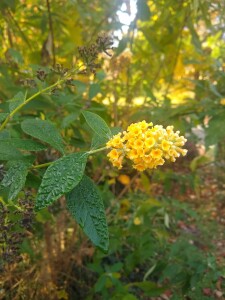 The gardening year is full of milestone—the solstices and equinoxes, the first and last frost dates, and, for some, the phases of the moon. I mark all of those, linking specific actions to them, but I also observe other, less universally applicable milestones that are equally significant to me. I note the first and last butterfly appearances of the year, as well as the first rose bloom and the final one.
The gardening year is full of milestone—the solstices and equinoxes, the first and last frost dates, and, for some, the phases of the moon. I mark all of those, linking specific actions to them, but I also observe other, less universally applicable milestones that are equally significant to me. I note the first and last butterfly appearances of the year, as well as the first rose bloom and the final one.
The last butterfly sighting happened several weeks ago, and I am still waiting for the last rose to open up. That has made me think about the last bouquet of the season.
At least once a week, I pick flowers and greens from the garden for cut flower arrangements in the house. I put them in containers from my collection of old china, silver and pottery vessels and enjoy the color and scent as I come and go through the rooms of my house. In the winter I still use greens from the garden, but augment my arrangements with cut flowers from the supermarket. Those satisfy my need for blooms, but are just a little less gratifying than the flowers that I grow myself. That is why I always have a little pang of seasonal disappointment when I make the last garden flower arrangement.
My final bouquets usually include a stray aster or two, a lonely ‘Honorine Jobert anemone that has managed to evade the hungry deer, and several clusters of blooms from the white-flowered rose that grows in front of my living room. I add in a few dried hydrangea flowerheads that have retained some of their original color. Usually I find blue ones on the backs of the bushes in my lower back yard. Their puffiness fills out the arrangements and also gives Saki the cat—who seems to harbor fantasies of becoming a florist—something crispy and interesting to pull out of the vase and/or rub his face on.
The last few bouquets almost always contain flower panicles from a butterfly bush. The purple-flowered ones have long since produced their last blooms, but my yellow-flowered ‘Honeycomb’ shrub, known botanically as Buddleia x weyeriana ‘Honeycomb’ continues bravely until the first hard frost. It is always the last to flower in the spring, but compensates by closing out the fall season.
‘Honeycomb’s flowers live up to their name, with each tiny bloom glowing yellow at the petal edges and warm yellow-orange at the throat. The individual panicles, made up of scores of flowers, are about six inches long and fragrant, though not as alluring as those on the purple-flowered varieties. The last butterflies and the hungry bees increasingly find their way to the shrub as weather begins to limit their other options.
This particular butterfly bush was the last of the three in my yard to be installed, and it has the least promising position. It sits on a corner of the front yard, in front of a privet hedge and shaded for a small part of the day by a nearby maple tree. The maple, which is moving through the process of slow death, has shed branches on the butterfly bush side for the last several years. This has produced a life and death dichotomy—the more sad and unhealthy the tree looks, the better the appearance of the butterfly bush. I prune the shrub back at the end of each season, leaving woody stems that are about 18-inches tall. Those stems sprout new growth in the spring and this year that new growth has culminated in branches that reach about seven feet tall.
I should probably follow my own advice and trim ‘Honeycomb’ back after every flush of bloom, but I usually forget and count on the plant to forgive me. Next year I may remember, and the pruning will produce a more compact plant, but there are no guarantees when it comes to future completion of garden chores.
In addition to filling out end-of-season bouquets, ‘Honeycomb’, being a hybrid, does not produce the endless crowd of seedlings that I invariably find around my other butterfly bushes. Though unwanted offspring are not a deal-breaker for me, the fact that ‘Honeycomb’ does not produce them leaves me more time to root out the hundreds of rose-of-Sharon seedlings that crop up nearby.
There is always something to do in the garden, especially when daylight grows short and working hours grow long. Picking and arranging the last bouquets are among the most pleasurable activities. In December and January I take comfort in those memories as I pick sprigs of chilly euonymus and holly to supplement my supermarket flowers.
